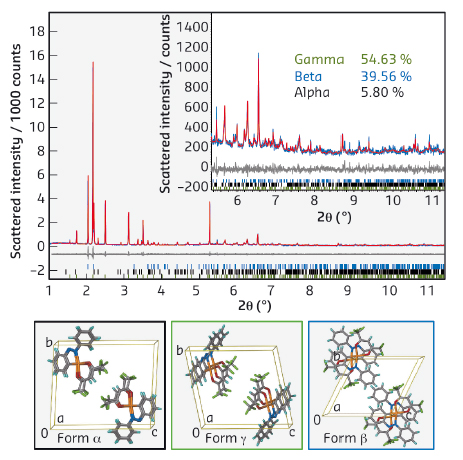- Home
- Users & Science
- Scientific Documentation
- ESRF Highlights
- ESRF Highlights 2014
- Structure of materials
- In situ monitoring of “jumping crystals” by X-ray powder diffraction
In situ monitoring of “jumping crystals” by X-ray powder diffraction
Certain crystals, when taken over a phase transition, are capable of self-actuation, jumping, exploding, bending or changing their physical appearance, thus presenting a novel platform for clean and effective conversion of thermal energy to mechanical work [1–3]. These thermosalient crystals, in the near future, might also find other applications, such as smart medical devices and implants, artificial muscles, actuators, sensors, electromechanical devices, to name but a few.
This extremely rare phenomenon of “jumping crystals” was noticed in the 1980s and remained poorly understood ever since. Etter and Siedle reported that when crystals of (phenylazophenyl)palladium hexafluoroacetylacetonate (PHA) are heated, they “literally fly off the hot stage” [4]. This impressive dynamic effect is captured in Figure 140.
 |
|
Fig. 140: Snapshots (taken at frequency 103 s-1) of the kinematic effect of hopping of PHA crystals. |
Although this system could help to understand how ordered matter responds to extreme internal pressures and performs locomotion, the relationships between the structural, mechanistic and kinematic aspects of this system have remained unknown.
When single crystals of PHA jump, they increase their mosaicity and disintegrate, thwarting the crystal structure solution by single crystal diffraction. The macroscopic disintegration of single crystals is all but an obstacle for powder diffraction (XRPD), and this method was used to investigate the system in greater detail. A laboratory XRPD study revealed as many as 5 polymorphs between 98 and 388 K (a record for the largest number of polymorphs of an organometallic compound). Our crystallographic, thermogravimetric, microscopic and spectroscopic analyses revealed that when heated, crystals of form alpha undergo two subsequent phase transformations: alpha–to–gamma, which is accompanied by jumping of the crystals, and gamma–to–beta, which is not thermosalient. Determination of the crystal structure of form gamma was crucial to understand the jumping effect in PHA. This phase was found to exist in a triple mixture with alpha and beta (Figure 141). Moreover, the relative amounts of the phases were found to change under isothermal conditions.
 |
|
Fig. 141: Rietveld plot of a three-phase refinement of PHA polymorphs used to detail the crystal structure of the gamma form, which is relevant to the thermosalient behaviour. The crystal packing diagrams of forms alpha, gamma and beta are given in the lower panels. |
When dealing with crystal structures of metastable species, it is necessary that the data are collected at the same (or preferably lower) timescale relative to the lifespan of the metastable structures. Laboratory XRPD data, of suitable quality for ab initio crystal structure solution, requires hours for collection, thus conventional X-ray sources could not be applied to study this system. The high-resolution diffraction data collected at beamline ID31 (now ID22), with a time-resolution of 3 minutes per powder pattern, made this complicated system amenable to structural investigations (Figure 141).
The crystal structures of forms alpha and beta were already known [4]. The solution of the structure of form gamma provided us with a unique possibility to follow the structural changes on the alpha-gamma-beta phase transitions and to relate them to the thermosalient effect. During the phase transition accompanied by jumping, layers of molecules in form alpha slide atop each other, which results in slanting of the columns of stacked molecules that generates immense internal strain, which is released in form of forceful jumps of the crystals and phase transformation into form gamma. In the second phase transition, alternating layers of molecules in form gamma slide in opposite directions and interdigitate into the thermodynamically stable head-to-tail stacking pattern of form beta.
The detailed crystallographic study of this intriguing “jumping crystal” phenomenon was only possible by using high-intensity and high-resolution synchrotron radiation. The PHA research project once again demonstrated the necessity of acquiring high-resolution diffraction data in frontier studies of novel materials.
Principal publication and authors
M.K. Panda (a), T. Runčevski (b), S.C. Sahoo (a), A.A. Belik (c), N.K. Nath (d), R.E. Dinnebier (b) and P. Naumov (a), Nature Communications 5, 4811 (2014).
(a) New York University Abu Dhabi, Abu Dhabi (United Arab Emirates)
(b) Max Planck Institute for Solid State Research, Stuttgart (Germany)
(c) National Institute for Materials Science, Tsukuba (Japan)
References
[1] Ž. Skoko, S. Zamir, P. Naumov and J. Bernstein, J. Am. Chem. Soc. 132, 14191 (2010).
[2] S.C. Sahoo, S.B. Sinha, M.S.R.N. Kiran, U. Ramamurty, A. Dericioglu, M.C. Reddy and P. Naumov, J. Am. Chem. Soc. 135, 13843 (2013).
[3] S.C. Sahoo, M. Panda, N.K. Nath and P. Naumov, J. Am. Chem. Soc. 135, 12241 (2013).
[4] M.C. Etter and A.R. Siedle, J. Am. Chem. Soc. 105, 641 (1983).



